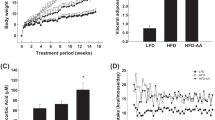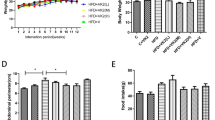Abstract
Nonalcoholic fatty liver disease (NAFLD) is characterized by hepatic lipid deposition and coincides often with cardiometabolic diseases. Several dietary factors attenuate NAFLD. Here, we report beneficial effects of chronic dietary capsaicin intake on NAFLD which is mediated by the transient receptor potential vanilloid 1 (TRPV1) activation. The results showed that TRPV1 activation by capsaicin reduced free fatty acids (FFAs) induced the intracellular lipid droplets in HepG2 cells and prevented fatty liver in vivo. Chronic dietary capsaicin promoted lipolysis by increasing hepatic phosphorylated hormone-sensitive lipase (phospho-HSL), carnitine palmitoyltransferase 1 (CPT1), and peroxisome proliferator-activated receptor δ (PPARδ) in wild-type (WT) mice. This effect was absent in TRPV1−/− mice. Dietary capsaicin did not affect lipogenesis, as indicated by the detection of hepatic fatty acid synthase (FAS), sterol regulatory element-binding protein-1 (SREBP-1), PPARα, and liver X receptor (LXR) in mice. Importantly, TRPV1 causes PPARδ activation which significantly increased the expression of autophagy-related proteins, such as light chain 3 (LC3)II, Beclin1, Atg5, and Atg7 in HepG2 cells. In the in vivo study, TRPV1 activation by dietary capsaicin enhanced hepatic PPARδ and autophagy-related proteins and reduced hepatic enzymes and inflammatory factor in WT but not TRPV1−/− mice. TRPV1 activation by dietary capsaicin prevents NAFLD through PPARδ-dependent autophagy enhancement in mice. Dietary capsaicin may represent a beneficial intervention in populations at high risk for NAFLD.









Similar content being viewed by others
Abbreviations
- NAFLD:
-
Nonalcoholic fatty liver disease
- WT:
-
Wild-type
- TRPV1:
-
Transient receptor potential vanilloid 1
- TRPV1−/− :
-
TRPV1 knockout
- FFAs:
-
Free fatty acids
- HSL:
-
Hormone-sensitive lipase
- CPT1:
-
Carnitine palmitoyltransferase 1
- ATGL:
-
Adipose triglyceride lipase
- PPAR:
-
Peroxisome proliferator-activated receptor
- FAS:
-
Fatty acid synthase
- SREBP-1:
-
Sterol regulatory element-binding protein-1
- LXR:
-
Liver X receptor
- LC3:
-
Light chain 3
- LDs:
-
Lipid droplets
- DMEM:
-
Dulbecco's modified Eagle's medium
- FBS:
-
Fetal bovine serum
- CAP:
-
Capsaicin
- CAPZ:
-
Capsazepine
- GAPDH:
-
Glyceraldehyde-3-phosphate dehydrogenase
- ALT:
-
Alanine aminotransferase
- AST:
-
Aspartate aminotransferase
- TNFα:
-
Tumor necrosis factor α
References
Alisi A, Feldstein AE, Villani A, Raponi M, Nobili V (2012) Pediatric nonalcoholic fatty liver disease: a multidisciplinary approach. Nat Rev Gastroenterol Hepatol 9:152–161
Amir M, Czaja MJ (2011) Autophagy in nonalcoholic steatohepatitis. Expert Rev Gastroenterol Hepatol 5:159–166
Argo CK, Loria P, Caldwell SH, Lonardo A (2008) Statins in liver disease: a molehill, an iceberg, or neither? Hepatology 48:662–669
Bellentani S, Dalle Grave R, Suppini A, Marchesini G (2008) Behavior therapy for nonalcoholic fatty liver disease: the need for a multidisciplinary approach. Hepatology 47:746–754
Chamulitrat W, Burhenne J, Rehlen T, Pathil A, Stremmel W (2009) Bile salt-phospholipid conjugate ursodeoxycholyl lysophosphatidylethanolamide as a hepatoprotective agent. Hepatology 50:143–154
Ducheix S, Lobaccaro JM, Martin PG, Guillou H (2011) Liver X Receptor: an oxysterol sensor and a major player in the control of lipogenesis. Chem Phys Lipids 164:500–514
El-Badry AM, Moritz W, Contaldo C, Tian Y, Graf R, Clavien PA (2007) Prevention of reperfusion injury and microcirculatory failure in macrosteatotic mouse liver by omega-3 fatty acids. Hepatology 45:855–863
Fabbrini E, Sullivan S, Klein S (2010) Obesity and nonalcoholic fatty liver disease: biochemical, metabolic, and clinical implications. Hepatology 51:679–689
Farrell GC, Larter CZ (2006) Nonalcoholic fatty liver disease: from steatosis to cirrhosis. Hepatology 43:S99–S112
Hailey DW, Rambold AS, Satpute-Krishnan P, Mitra K, Sougrat R, Kim PK, Lippincott-Schwartz J (2010) Mitochondria supply membranes for autophagosome biogenesis during starvation. Cell 141:656–667
Harrison SA (2010) Thiazolidinedione therapy for nonalcoholic steatohepatitis: go, stop, or proceed with caution? Hepatology 51:366–369
He H, Yang D, Ma L, Luo Z, Ma S, Feng X, Cao T, Yan Z, Liu D, Tepel M, Zhu Z (2010) Telmisartan prevents weight gain and obesity through activation of peroxisome proliferator-activated receptor-delta-dependent pathways. Hypertension 55:869–879
Henao-Mejia J, Elinav E, Jin C, Hao L, Mehal WZ, Strowig T, Thaiss CA, Kau AL, Eisenbarth SC, Jurczak MJ, Camporez JP, Shulman GI, Gordon JI, Hoffman HM, Flavell RA (2012) Inflammasome-mediated dysbiosis regulates progression of NAFLD and obesity. Nature 482:179–185
Holzer P (2011) Transient receptor potential (TRP) channels as drug targets for diseases of the digestive system. Pharmacol Ther 131:142–170
Jensen-Urstad AP, Semenkovich CF (2012) Fatty acid synthase and liver triglyceride metabolism: housekeeper or messenger? Biochim Biophys Acta 1821:747–753
Jiang M, Fernandez S, Jerome WG, He Y, Yu X, Cai H, Boone B, Yi Y, Magnuson MA, Roy-Burman P, Matusik RJ, Shappell SB, Hayward SW (2010) Disruption of PPARgamma signaling results in mouse prostatic intraepithelial neoplasia involving active autophagy. Cell Death Differ 17:469–481
Jiang M, Jerome WG, Hayward SW (2010) Autophagy in nuclear receptor PPARgamma-deficient mouse prostatic carcinogenesis. Autophagy 6:175–176
Lavine JE, Schwimmer JB, Van Natta ML, Molleston JP, Murray KF, Rosenthal P, Abrams SH, Scheimann AO, Sanyal AJ, Chalasani N, Tonascia J, Unalp A, Clark JM, Brunt EM, Kleiner DE, Hoofnagle JH, Robuck PR (2011) Effect of vitamin E or metformin for treatment of nonalcoholic fatty liver disease in children and adolescents: the TONIC randomized controlled trial. JAMA 305:1659–1668
Li L, Chen J, Ni Y, Feng X, Zhao Z, Wang P, Sun J, Yu H, Yan Z, Liu D, Nilius B, Zhu Z (2012) TRPV1 activation prevents nonalcoholic fatty liver through UCP2 upregulation in mice. Pflugers Arch 463:727–732
Liu L, Feng D, Chen G, Chen M, Zheng Q, Song P, Ma Q, Zhu C, Wang R, Qi W, Huang L, Xue P, Li B, Wang X, Jin H, Wang J, Yang F, Liu P, Zhu Y, Sui S, Chen Q (2012) Mitochondrial outer-membrane protein FUNDC1 mediates hypoxia-induced mitophagy in mammalian cells. Nat Cell Biol 14:177–185
Malavazos AE, Gobbo G, Zelaschi RF, Cereda E (2010) Lifestyle intervention and fatty liver disease: the importance of both disrupting inflammation and reducing visceral fat. Hepatology 51:1091–1092
Miao X, Liu G, Xu X, Xie C, Sun F, Yang Y, Zhang T, Hua S, Fan W, Li Q, Huang S, Wang Q, Zhong D (2008) High expression of vanilloid receptor-1 is associated with better prognosis of patients with hepatocellular carcinoma. Cancer Genet Cytogenet 186:25–32
Musso G, Gambino R, Cassader M (2010) Emerging molecular targets for the treatment of nonalcoholic fatty liver disease. Annu Rev Med 61:375–392
Nagasawa T, Inada Y, Nakano S, Tamura T, Takahashi T, Maruyama K, Yamazaki Y, Kuroda J, Shibata N (2006) Effects of bezafibrate, PPAR pan-agonist, and GW501516, PPARdelta agonist, on development of steatohepatitis in mice fed a methionine- and choline-deficient diet. Eur J Pharmacol 536:182–191
Nilius B, Owsianik G (2011) The transient receptor potential family of ion channels. Genome Biol 12:218
Nilius B, Owsianik G, Voets T, Peters JA (2007) Transient receptor potential cation channels in disease. Physiol Rev 87:165–217
Nilius B, Vennekens R, Owsianik G (2008) Vanilloid transient receptor potential cation channels: an overview. Curr Pharm Des 14:18–31
Oh SH, Kim YS, Lim SC, Hou YF, Chang IY, You HJ (2008) Dihydrocapsaicin (DHC), a saturated structural analog of capsaicin, induces autophagy in human cancer cells in a catalase-regulated manner. Autophagy 4:1009–1019
Ost A, Svensson K, Ruishalme I, Brannmark C, Franck N, Krook H, Sandstrom P, Kjolhede P, Stralfors P (2010) Attenuated mTOR signaling and enhanced autophagy in adipocytes from obese patients with type 2 diabetes. Mol Med 16:235–246
Park HJ, DiNatale DA, Chung MY, Park YK, Lee JY, Koo SI, O'Connor M, Manautou JE, Bruno RS (2011) Green tea extract attenuates hepatic steatosis by decreasing adipose lipogenesis and enhancing hepatic antioxidant defenses in ob/ob mice. J Nutr Biochem 22:393–400
Qin X, Xie X, Fan Y, Tian J, Guan Y, Wang X, Zhu Y, Wang N (2008) Peroxisome proliferator-activated receptor-delta induces insulin-induced gene-1 and suppresses hepatic lipogenesis in obese diabetic mice. Hepatology 48:432–441
Rautou PE, Mansouri A, Lebrec D, Durand F, Valla D, Moreau R (2010) Autophagy in liver diseases. J Hepatol 53:1123–1134
Sharma S, Mells JE, Fu PP, Saxena NK, Anania FA (2011) GLP-1 analogs reduce hepatocyte steatosis and improve survival by enhancing the unfolded protein response and promoting macroautophagy. PLoS One 6:e25269
Shin HW, Kim D, Lee Y, Yoo HS, Lee BJ, Kim JS, Jang S, Lim H, Oh S (2009) Alteration of sphingolipid metabolism and pSTAT3 expression by dietary cholesterol in the gallbladder of hamsters. Arch Pharm Res 32:1253–1262
Siemens J, Zhou S, Piskorowski R, Nikai T, Lumpkin EA, Basbaum AI, King D, Julius D (2006) Spider toxins activate the capsaicin receptor to produce inflammatory pain. Nature 444:208–212
Singh R, Kaushik S, Wang Y, Xiang Y, Novak I, Komatsu M, Tanaka K, Cuervo AM, Czaja MJ (2009) Autophagy regulates lipid metabolism. Nature 458:1131–1135
Tailleux A, Wouters K, Staels B (2012) Roles of PPARs in NAFLD: potential therapeutic targets. Biochim Biophys Acta 1821:809–818
Widhalm K, Ghods E (2010) Nonalcoholic fatty liver disease: a challenge for pediatricians. Int J Obes (Lond) 34:1451–1467
Wu X, Zhang L, Gurley E, Studer E, Shang J, Wang T, Wang C, Yan M, Jiang Z, Hylemon PB, Sanyal AJ, Pandak WM Jr, Zhou H (2008) Prevention of free fatty acid-induced hepatic lipotoxicity by 18beta-glycyrrhetinic acid through lysosomal and mitochondrial pathways. Hepatology 47:1905–1915
Yang D, Luo Z, Ma S, Wong WT, Ma L, Zhong J, He H, Zhao Z, Cao T, Yan Z, Liu D, Arendshorst WJ, Huang Y, Tepel M, Zhu Z (2010) Activation of TRPV1 by dietary capsaicin improves endothelium-dependent vasorelaxation and prevents hypertension. Cell Metab 12:130–141
Yang L, Li P, Fu S, Calay ES, Hotamisligil GS (2010) Defective hepatic autophagy in obesity promotes ER stress and causes insulin resistance. Cell Metab 11:467–478
York LW, Puthalapattu S, Wu GY (2009) Nonalcoholic fatty liver disease and low-carbohydrate diets. Annu Rev Nutr 29:365–379
Zhang LL, Yan Liu D, Ma LQ, Luo ZD, Cao TB, Zhong J, Yan ZC, Wang LJ, Zhao ZG, Zhu SJ, Schrader M, Thilo F, Zhu ZM, Tepel M (2007) Activation of transient receptor potential vanilloid type-1 channel prevents adipogenesis and obesity. Circ Res 100:1063–1070
Acknowledgments
We thank Quan Chen (The State Key Laboratory of Biomembrane and Membrane Biotechnology, Institute of Zoology, Chinese Academy of Sciences, Beijing, China) for presenting GFP-LC3 plasmid. We thank Tingbin Cao and Lijuan Wang (Chongqing Institute of Hypertension, China) for technical assistance. We thank Bin Tan (Institute of Pediatrics, Chongqing Medical Science University) for immunofluorescence images. We thank Yu Huang (Chinese University of Hong Kong, China) for critical review of the manuscript.
Sources of Funding
The National Basic Research Program of China (2012CB517805 and 2012CB517806 and 2011CB503902) and the National Natural Science Foundation of China (30890042).
Author information
Authors and Affiliations
Corresponding authors
Additional information
Qiang Li and Li Li contributed equally to this work.
Electronic supplementary material
Below is the link to the electronic supplementary material.
ESM 1
(DOC 1966 kb)
Rights and permissions
About this article
Cite this article
Li, Q., Li, L., Wang, F. et al. Dietary capsaicin prevents nonalcoholic fatty liver disease through transient receptor potential vanilloid 1-mediated peroxisome proliferator-activated receptor δ activation. Pflugers Arch - Eur J Physiol 465, 1303–1316 (2013). https://doi.org/10.1007/s00424-013-1274-4
Received:
Accepted:
Published:
Issue Date:
DOI: https://doi.org/10.1007/s00424-013-1274-4




